Instrumentation
Without great instrumentation, great science would not be possible. With in-house engineers and close ties to the UW-Madison Physical Sciences Laboratory (PSL) in Stoughton, Wisconsin, WIPAC is a place where scientific instrumentation is designed, developed, and tested.
Our relationship with PSL began in the mid-90s as physicists were building digital optical modules (DOMs) for the Antarctic Muon and Neutrino Detector Array, or AMANDA. AMANDA was a proof-of-concept for IceCube.
IceCube, as one of the world’s largest scientific instruments, required innovative engineering to build detector components and construction equipment. Among the most impressive: the digital optical module and the hot water drill.
Upgrades, new developments, and calibration testing are ongoing.
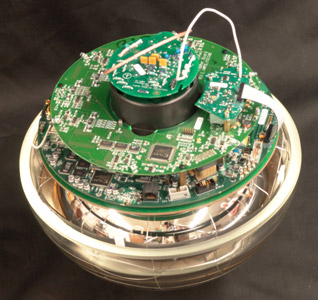
NSF/IceCube Collaboration
Digital Optical Module, or DOM
Known to project members as “DOMs,” digital optical modules make up the “eyes” of the IceCube Neutrino Observatory. The cubic kilometer of ice that comprises the detector houses over 5,000 of them; the surface array IceTop brings the total up to 5,484.
Each DOM is a basketball-sized computer encased in one inch glass. The bottom half mostly houses the photomultiplier tube, a sort of reverse lightbulb that detects light emitted during neutrino interactions.
DOMs are connected to the IceCube Lab on the surface of the ice via computer cables. All data about neutrino events is sent from the lab via satellite to be processed and sorted in the north.
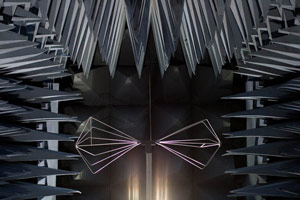
NSF/L.Norris
Anechoic Chamber
Located in Stoughton, Wisconsin, at PSL, this anechoic chamber is designed to stop the reflection of electromagnetic waves and is intended for testing antennas and other hardware of the Askaryan Radio Array, or ARA.
The chamber itself was designed by New York-based Universal Shielding Corporation, and was assembled at PSL by WIPAC instrumentation staff.
An anechoic chamber insulates against electromagnetic waves through the exterior of the chamber, which is made out of metal and provides a barrier against waves.
The interior of the chamber is lined with spikes made out of foam. The spikes “simulate infinity” so that when antennas are tested inside the chamber, reflections are absorbed in the walls and staff can confirm that the equipment is receiving a straight wave.
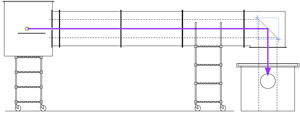
NSF/IceCube Collaboration
Photomultiplier Sensitivity Testing
For IceCube and HAWC, the central mechanism for particle detection is the photomultiplier tube, or PMT. PMTs are extremely sensitive to light and they can see the burst of blue Cherenkov radiation emitted when a neutrino interacts in the ice at the South Pole (IceCube) or the water that surrounds the HAWC detectors.
At Chamberlin Hall, where WIPAC students and researchers have offices in the Department of Physics, PMT measurements are being taken to determine sensitivity. The setup consists of a light source at the end of a tunnel. Light travels through the tunnel and is reflected via a mirror downwards, where a PMT sits in a tank of water.
IceCube DOMs or HAWC PMTs will be held under water and automatically rotated to measure response vs. angle and other capabilities. For IceCube, data will be compared against in-ice muon measurements and previous lab measurements.
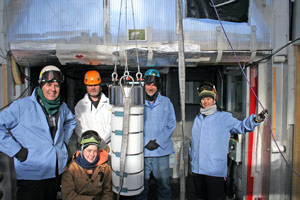
NSF/DM-Ice Collaboration
Dark Matter Detector
Currently, two DM-Ice detectors are deployed in the South Pole ice, each at the end of an IceCube string. The goals of the current experiment are to assess the feasibility of deploying NaI(TI) crystals in the ice, check the radio purity of the ice, and explore the capability of IceCube to veto muons.
The detectors themselves consist of NAIAD NaI crystals in stainless steel pressure vessels. The vessels have been tested to withstand 6200 psi, a requirement for in-ice instrumentation since pressure often goes above 6000 psi as the holes refreeze.
Design and R&D studies are underway for a full-scale experiment.
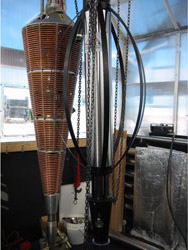
NSF/IceCube Collaboration
Enhanced Hot Water Drill
The IceCube Neutrino Observatory was built entirely under the surface of the ice at the South Pole in Antarctica. This incredible feat of engineering and construction was accomplished thanks to the Enhanced Hot Water Drill.
Development of the drill began at UW-Madison Physical Sciences Laboratory (PSL) in 1995. At that time, IceCube had not yet been proposed and researchers were working on the proof-of-concept, a smaller scale neutrino detector called AMANDA, or the Antarctic Muon and Neutrino Detector Array.
The finished drill dropped to depths of over 2 kilometers in about 1.5 days. A modular head was created to meet requirements: it had to withstand external pressure of 5000 pounds per inch, send and receive signals through thousands of feet of cable, and stay in a straight line.

